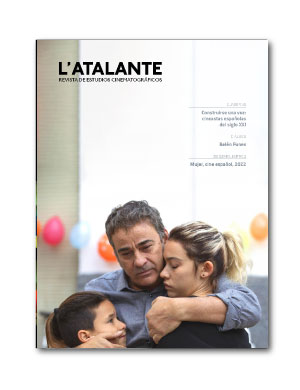Filmic Voices in Pilar Palomero’s 'Schoolgirls': Be- hind the Scenes of the Generation of 1992
Published 2025-04-25
Keywords
- Filmic voice,
- Memory,
- Schoolgirls,
- Pilar Palomero.
How to Cite
Copyright (c) 2022 L'Atalante. Journal of film studies

This work is licensed under a Creative Commons Attribution-NonCommercial-NoDerivatives 4.0 International License.
Abstract
Pilar Palomero’s first feature film, Schoolgirls (Las niñas, 2020), offers a good example of how to create a voice for a generation of girls who came of age in the 1990s. The film offers a young person’s perspective on the transition from childhood to adolescence, representing it as a journey of discovery. This article explores the staging of the voice,
which is highly significant right from the beginning of the film, and the way that the director effectively creates a voice for Celia’s generation. So how does Palomero create a gaze on silence while telling the story of what happens behind the scenes at a school in 1992?
Downloads
References
<p>Altman, R. (1987). <em>The American Film Musical.</em> Bloomington/Indianapolis: Indiana University Press.<br>
Assmann, A. (2008). Communicative and Cultural Memory. En A. Erl, A. Nunning (dir.), <em>Cultural Memory Studies. An International and Interdisciplinary Handbook </em>(pp. 109-118). Berlin, New York: De Gruyter.<br>
Assmann, A. (2010). Reframing Memory. Between individual and collective forms of constructing the past. En K. Tilmans, J. Winter, F. van Vree, (eds.), <em>Performing the Past</em>. <em>Memory, History and Identity in Modern Europe </em>(pp. 36-50). Amsterdam: Amsterdam University Press.<br>
Aumont<em>, </em>J. (1998).<em> El rostro en el cine.</em> Barcelona: Paidós Comunicación.<br>
Austin<em>, </em>J.L. (1962). <em>How To Do Things With Words.</em> Cambridge: Harvard University Press.<br>
Bhabha, Homi, K., (1994), <em>The Location of Culture</em>, London, New York: Routledge.<br>
Chion<em>, </em>M. (1982). <em>La voix au cinema</em>. París: Editions Cahiers du cinema.<br>
Chion<em>, </em>M. (1998). Les nouveaux masques de la voix. Notes sur une évolution de la voix au cinéma des années 80 et 90. <em>Médiation et Information, 9</em>, 12-23.<br>
Feenstra, P. (2014) ¿Cómo leer los nuevos enfoques sobre mujeres directoras? Archivar, visibilizar, escenificar. En P. Feenstra, E. Gimeno Ugalde, K. Sartingen (eds), <em>Directoras de cine en España y América Latina: nuevas voces y miradas </em>(pp. 37-70). Frankfurt am Main: Peter Lang. <br>
Feenstra, P. (2018). Canciones dialécticas y posmemoria. <em>Cría cuervos</em> y <em>La mujer sin cabeza</em>. En P. Piedras, S. Dufays (eds.), <em>Conozco la canción. Melodías populares en los cines posclásicos de América Latina y Europa </em>(pp. 324-337). Buenos Aires: Librería Ediciones.<br>
Feenstra P. (2021). La foto-memoria de los títulos de crédito en la obra de Carlos Saura: El séptimo día (2003), un ejemplo paradigmático. En N. Berthier, M. Bloch-Robin (eds), <em>Carlos Saura o el arte de heredar </em>(pp. 216-237)<em>.</em> Santander: Ediciones Shangrila.<br>
Feenstra, P., Gimeno Ugalde, E., Sartingen, K. (eds.) (2014). <em>Directoras de cine en España y América Latina: nuevas voces y miradas</em> Frankfurt am Main: Peter Lang.<br>
Flécheux, C. (2014). <em>L’horizon. </em>París: Klincksieck.<br>
Gimeno Ugalde, E. (2014). Presencias (in)visibles: directoras en el cine español y latinoamericano. En P. Feenstra, E. Gimeno Ugalde, K. Sartingen (eds), <em>Directoras de cine en España y América Latina: nuevas voces y miradas</em>(pp. 71-145). Frankfurt am Main: Peter Lang.<br>
Halbwachs, M. (1925). <em>Les cadres sociaux de la mémoire. </em>París: Librairie Félix Alcan. <br>
Halbwachs, M. (1950). <em>La mémoire collective.</em> París: Les Presses Universitaires de France. <br>
https://cpaformacion.com/entrevista-carlos-naya-lunas-de-papel/. Consultado el 30 de septiembre 2021<br>
Le Breton, D. (2011). <em>Eclats de voix. Una anthropologie des voix.</em> París: Ed. Métailié.<br>
Leiris, M, (1992), <em>La langue secrète des Dogons de Sanga</em>, París: Jean-Michel Place.<br>
Powrie, P. La ‘chanson-cristal’. En R. Lagabrielle, T. Obergoker (ed.), <em>La chanson dans le film français et francophone depuis la Nouvelle Vague </em>(pp. 67-77). Würzburg: Verlag Koenigshausen Neumann.<br>
Searle, J. (1969). <em>Speech acts.</em> Cambridge: Cambridge University Press.<br>
Tylski, A. (2008).<em> Le générique de cinéma. Histoire et fonctions d’un fragment hybride. </em>Toulouse: Presses Universitaires du Mairail.</p>
</body>

